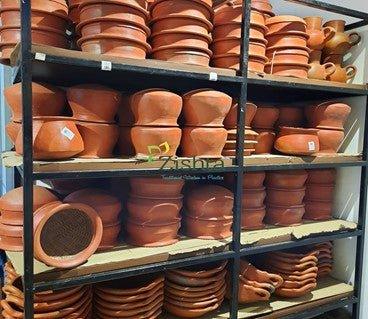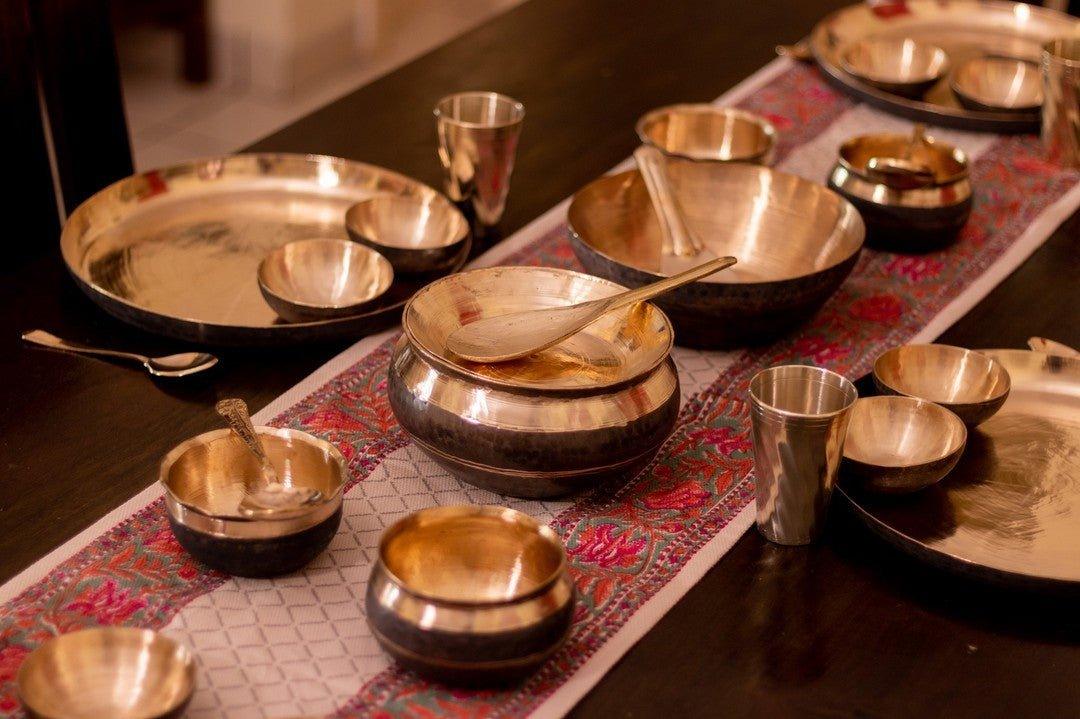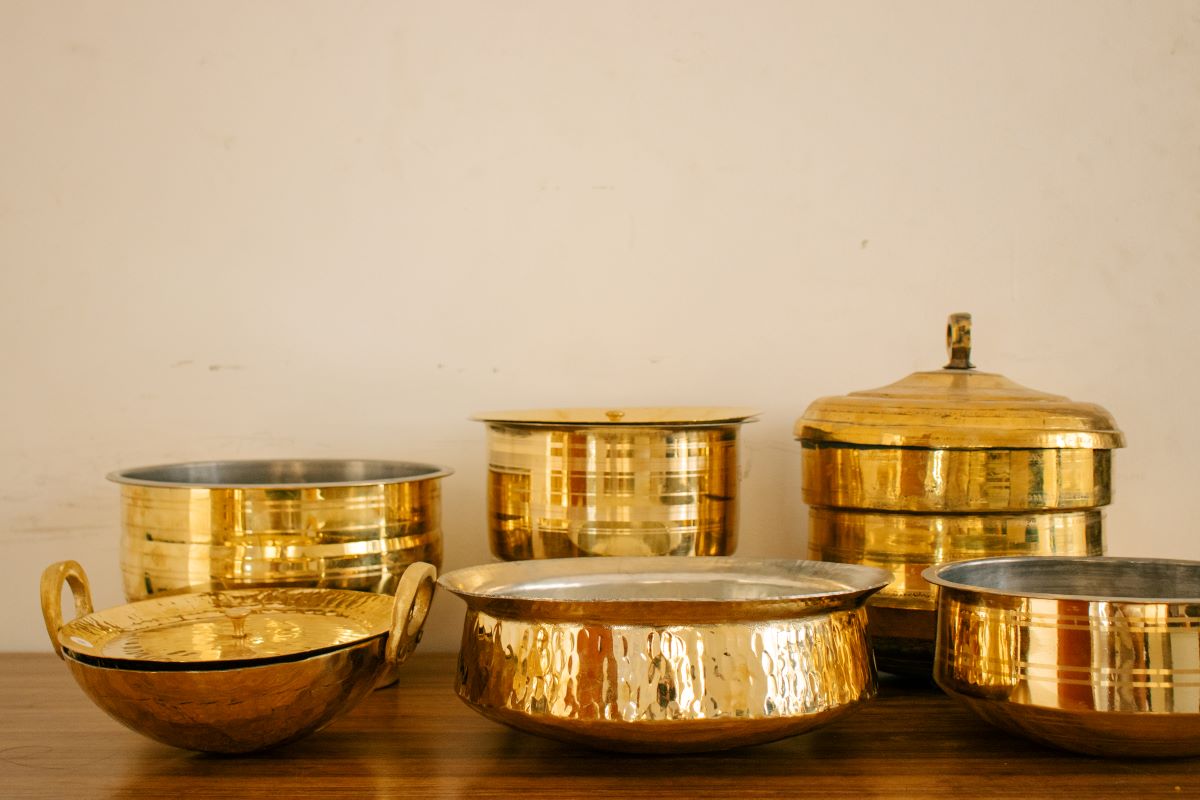1) What is clayware?
Clay cookware is a type of cooking vessel made from natural clay that is used for cooking and serving food. Clay utensils has been used for centuries in many different cultures around the world, including India, Mexico, and the Mediterranean region.
Clay cookware is typically unglazed and porous, which means it allows for the circulation of steam and heat. This helps to retain moisture and enhance the flavour of the food being cooked. It also promotes even heat distribution, which helps to prevent hot spots and burning.
Some common types of clay cookware include clay pots, tagines, cazuelas, and tandoors. Clay pots are typically used for slow-cooking stews, curries, and soups, while tagines and cazuelas are used for cooking meat, rice, and vegetables. Tandoors are a type of clay oven that is used to bake bread, meats, and other dishes.
2) Is it safe to cook in clay pots?
Yes, it is generally safe to cook in clay pots if it is properly made and used correctly. Clay cookware has been used for centuries in many cultures and is considered safe and healthy for cooking.
Make sure the clay comes from good source and is un-glazed.
3) What is clay cookware best for?
Clay cookware is ideal for all forms of cooking with any kind of ingredients. The only limitation is deep frying as clay does not allow oil to heat up to the extent for deep frying like pakoras, samosas etc.
4) Which is the best clayware for cooking? How to identify best clayware?
Choose Unrefined Clay: Look for clay cookware that is made from unrefined clay that is free from any artificial additives or chemicals. Unrefined clay is typically brown or tan in colour and has a slightly rough texture.
Check for Lead and Cadmium Content: Clay cookware may contain harmful metals like lead and cadmium, which can leach into your food during cooking. To avoid this, look for cookware that has been certified as lead and cadmium-free by a trusted organization.
Check the Thickness: Look for clay cookware that is thick and heavy, as this will help to retain heat and ensure even cooking. Thicker cookware is also less likely to crack or break during cooking.
Check the Glaze: Make sure you buy unglazed clay for cooking. Glazing generally has higher lead content and is not recommended for cookware.
Consider the Size and Shape: Choose a size and shape that is appropriate for the type of cooking you plan to do. For example, a large pot is ideal for making soups and stews, while a small tagine is perfect for cooking rice or vegetables.
Listen to the Sound: Always knock at the bottom of the clay cookware and you should get a good metallic sound. That is an indication that the clay internal structure is strong and has no internal cracks. This is a measure of the strength of the clay cookware. If you hear a thud sound (dull) it is not an ideal new cookware to purchase.
Buy from a Trusted Source: Finally, make sure to buy clay cookware from a trusted source that specializes in this type of cookware. Look for reviews and recommendations from other customers to ensure you are getting a high-quality product.
5) Who makes clay pots?
At Zishta we source the clay cookware from a cluster of traditional makers present for centuries along the Cauvery delta region. River delta clay is always the strongest and do not have any impurities.
6) How are clay pots made?
Clay pots are typically made using traditional techniques that have been passed down through generations of potters. Here are the basic steps involved in making a clay pot:
Harvest the Clay: The first step is to find a suitable source of clay. The clay must be rich in minerals and free from impurities. The clay is usually extracted from a riverbed, a quarry, or a mine.
Prepare the Clay: The clay is then mixed with water and kneaded to remove any air pockets and to make it malleable. Depending on the region and the traditions, other materials like sand or grog can be added to the clay to give it more texture and strength.
Shape the Pot: Once the clay is ready, it is shaped into a pot using a potter's wheel or by hand. The potter will use a variety of tools to shape the pot, including a wet sponge, a rib, and a wooden knife.
Dry the Pot: After shaping the pot, it is left to dry for several days. This helps to remove any excess moisture and to harden the clay.
Fire the Pot: Once the pot is dry, it is fired in a kiln at high temperatures. Traditional makers pile up the dried-up clay cookware in a heap cover it with wet clay and leaves and fire it. This is the traditional process followed. This process sometimes burns the outer layers of cookware to darker (Blackish) state. Double baking these regular clay results in complete black clay cookware.
Decorate: To give a good finish, the artisans generally apply red sand paste (Completely natural) to smoothen out the surface and close excess pores. This cookware is dried up and ready for use.
Overall, making a clay pot is a time-consuming and labour-intensive process that requires a great deal of skill and experience. However, the result is a beautiful and functional piece of cookware that has been used for centuries in many different cultures around the world.
7) How to season clay pot?
Seasoning clay cooking pots helps to prevent food from sticking and strengthens the pot, making it more durable. Here are the steps to season clay cooking pots:
Heat it up in gas burner for 5-10 mins till cookware is completely hot.
Apply Oil: Rub the surface of the clay pot with a high-smoke point oil, such as vegetable oil or flaxseed oil. Use a paper towel or cloth to apply the oil evenly on the surface of the pot, inside and out.
Place in Gas Burner: Place the oiled clay pot and heat it again in low flame for 10 - 15 mins.
Cool and Wipe: Cool down the clay cookware. Once it has cooled, wipe off any excess oil with a paper towel.
Repeat: If you're seasoning a new clay pot, repeat this process two or three times to fully season it. For an old pot that hasn't been used in a while, you can season it once or twice to restore its non-stick surface.
It is important to note that different types of clay may require different seasoning methods, so it's best to refer to the manufacturer's instructions if available. Additionally, you should avoid using soap or abrasive cleaning materials on seasoned clay pots, as this can damage the seasoning and the pot's surface. Instead, clean it with warm water and a soft brush or cloth.
8) How to clean clay cookware?
Cleaning clay cookware requires some special attention to ensure that the porous surface of the clay does not retain any food residue or odours. Here are the steps to clean clay cookware:
Let the Cookware Cool Down: Always allow the clay cookware to cool down completely before cleaning. This prevents thermal shock that can cause cracks or damage to the clay.
Scrape Off Any Residue: Use a wooden or plastic spatula to remove any food or residue from the surface of the cookware.
Soak in Water: Fill the cookware with warm water and let it soak for 10-15 minutes. This softens any remaining food particles and makes them easier to remove.
Scrub Gently: Use a soft-bristled brush or a scrubber to gently clean the surface of the cookware. Do not use abrasive scrubbers or harsh cleaning agents, as these can damage the porous surface of the clay.
Rinse Thoroughly: Rinse the cookware thoroughly with warm water to remove any remaining food particles or soap residue.
Dry Completely: Allow the cookware to air dry completely before storing it. Do not use a towel or cloth to dry it, as this can leave behind lint or fibres that can get stuck in the porous surface of the clay.
It is also important to avoid soaking clay cookware for long periods of time, as this can cause the clay to absorb too much water and become brittle or crack. Additionally, avoid exposing clay cookware to sudden changes in temperature, such as placing it directly from the refrigerator to a hot oven. This can cause thermal shock and damage the clay.
9) What is earthen pot/clay cookware benefits?
Cooking in clay has several benefits, including:
Natural Material: Clay is a natural material that does not contain any harmful chemicals or toxins. This means that food cooked in clay is free from any potential chemical contamination.
Even Heat Distribution: Clay can distribute heat evenly, which allows food to cook more uniformly. This means that there are no hot spots or cold spots, resulting in better and more consistent cooking.
Non-Stick Surface: Clay cookware has a naturally non-stick surface, which means that less oil or fat is needed for cooking. This makes it a healthier cooking option.
Moisture Retention: Clay is porous and can retain moisture, which means that food cooked in clay is moist and flavourful. This also helps to prevent food from drying out or becoming tough.
Nutrient Retention: Clay cookware retains the nutrients and flavours of the food, which results in healthier and more flavourful meals. Modern study shows that natural materials like clay retain more than 95% of the nutrition of the food cooked in them.
Alkaline Property: Due to alkaline property of clay, cookware provides medium to neutralize the acidity of the food cooked in them.
Natural minerals addition: Being Porous and natural rich in micronutrients and minerals, natural addition of minerals and nutrients happen in usage of clay in your day-to-day cooking.
Environmentally Friendly: Clay cookware is environmentally friendly as it is made from natural materials and is biodegradable.
Aesthetically Pleasing: Clay cookware is aesthetically pleasing and adds a rustic touch to your kitchen.
Overall, cooking in clayware provides several benefits and is a healthy and environmentally friendly cooking option.
10) How to make out when earthenware is glazed?
To identify glazing in clay cookware, look for a smooth and shiny surface on the interior and/or exterior of the pot. Glazing is a coating of glass that is fused to the surface of the clay during firing, and it creates a non-porous, waterproof layer that seals the clay and prevents it from absorbing liquids or odours.
11) What are three types of earthenware?
There are many types of clay cookware, but three common types are:
Unglazed Clay Cookware: This type of clay cookware is made from natural, unglazed clay and is porous.
Glazed Clay Cookware: This type of clay cookware is coated with a layer of glaze, which makes it non-porous and water-resistant.
Terra Cotta Cookware: Terra cotta is a type of clay that is fired at low temperatures and is more porous than other types of clay.
12) Does earthenware break easily?
If dropped or handled roughly, clay cookware can surely crack and break. also please make sure they cool down completely before you wash them. Prevent thermal shock by suddenly changing temperatures during cooking.
13) Can clay pots be used on gas stove?
Yes. Clay is amazing to use on gas burner.
14) What is special about clay pots?
They are natural, Neutralize acidity and healthy!
15) Can we cook rice in clay pot?
Clay has been traditionally used for cooking all forms of food. The tall size clay pots are ideal for cooking rice. Due to its amazing moisture retention ability making the rice fluffy and not sticky.
16) How to cook rice in clay pot?
Wash rice well and fill the clay pot with water and heat it up (3- 4 cups of water for 1 cup of rice). Once it heats up, add the rice, and stir them gently. Stir occasionally to prevent rice from sticking to the bottom. Once cooked, check consistency of rice, and drain out any excess water.
17) What are the Disadvantages of cooking in clay pots?
While cooking in clay has many benefits, there are also some disadvantages to consider:
Fragile: Clay cookware can be fragile and may break easily if not handled carefully. This means that it requires careful handling and storage.
Long Heating Time: Clay cookware takes longer to heat up than other types of cookware, but once it heats up due to its high heat retention level, they cook the food uniformly and faster. Also it takes longer to cool down - so you may have to wait for some time before you wash the cookware.
Limited Heat Capacity: Clay cookware has a limited heat capacity and may not be suitable for high-temperature cooking. This means that it may not be the best option for searing or frying foods.
Absorbs Flavours: Because clay is porous, it can absorb flavours and odours from the food it is cooked in. This means that it may not be suitable for cooking a wide variety of dishes in the same pot.
Cleaning: Clay cookware requires special care when cleaning, as it cannot be washed in a dishwasher and may require hand washing with mild soap and water.
Overall, while cooking in clay has many benefits, it may not be the best option for all types of cooking and may require more care and attention than other types of cookware.
18) How to clean clay water bottle?
Rinse it thoroughly with water and then sun dry it. Sun drying opens the pores and removes any smell.
19) What are the Benefits of storing water in clay water bottle/Jug?
Storing water in clay is a traditional practice that has several potential benefits, including:
Natural Cooling: Clay pots can keep water cool naturally because the material is porous, allowing water to evaporate from the surface. As water evaporates, it cools the remaining water in the pot.
Alkalizing: Clay is alkaline in nature, which means that it can help to balance the pH level of the water stored in it. Alkaline water is believed to have several health benefits, including aiding digestion and reducing the risk of chronic diseases.
Mineral-Rich: Clay pots can leach minerals into the water stored in them, adding trace amounts of calcium, iron, and other minerals to the water. These minerals can be beneficial to overall health.
Eco-Friendly: Using clay pots to store water is a sustainable practice because it does not require the use of plastic or other synthetic materials. Clay pots are also biodegradable and do not release harmful chemicals into the environment.
It's important to note that while there are potential benefits to storing water in clay, it's also important to properly clean and maintain the pots to prevent the growth of harmful bacteria or mold. Additionally, clay pots can be fragile and may crack or break if not handled with care.
20) How to cure a clay water jug?
Take a new clay water jug or water bottle /pot - soak it water overnight with a hand full of salt. Soak it completely in a bucket of water. Remove it after 7-8 hours from water , dry it well in sun and then start using it to store water.




5 comments
Suvedha Kannan
Can we use clay pots on solid disk electric cooktop stoves? I am interested in using clay cookwares. But not sure, if I can use it on electric stove.
Vijay Painuly
Made for cley crockery all types.
I need some simple
Revaty
Can we store butter milk in ur clay jug?
Savita Laad
I am interested in buying a small clay pot for fish curry and 1 medium soapstone kalchetti from you . Bothe treated and unglazed . I am from South of Goa. Please send me the quotes with shipping charges and images of the products on my email
Savita Laad
I am interested in buying a small clay pot for fish curry and 1 medium soapstone kalchetti from you . Bothe treated and unglazed . I am from South of Goa. Please send me the quotes with shipping charges and images of the products on my email
Leave a comment
All comments are moderated before being published.
This site is protected by hCaptcha and the hCaptcha Privacy Policy and Terms of Service apply.